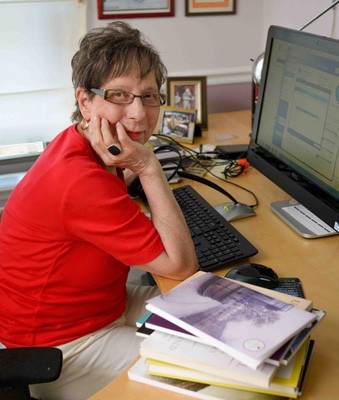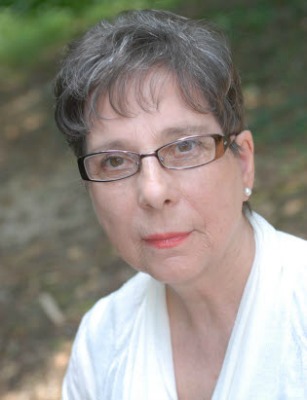
Grace Cavalieri
Grace Cavalieri is Maryland Poet Laureate. She’s visiting all Maryland counties working with teen poets.
The Poem as a Pie
I thank Carl Jung for his idea about a balanced life: four parts of the whole—the intellectual, emotional, sensual, and intuitive. Some of these aspects are dominant in our lives at different times. Anyone who knows me has seen these four qualities applied to a poem—not before the writing—that would be like a centipede trying to walk after knowing he has 1,000 legs; no, it’s after the poem’s first drafted that Jung comes to mind.
The four quadrants of a circle provide a good template to see what’s easy and natural for the poet, and what’s needed. Most young writers have the “thinking” part always available—telling us what ideas are driving them at the time. As for the “sensual”—even beginners can show a canny sensibility with imagery, sight, taste, and sound; the “feeling” may need a little cultivating, because it takes a while to throw away the instinct to say “I am sad, I am lonely” and opt instead for the bird alone on the branch, or show the cold rock in the desert.
We come to the fourth, and most elusive, piece of the four-piece pie: the “intuitive.” How to describe it? How to access it? What do we have to know to even understand this? Simply: I think it speaks to what’s left out of the poem, the invisible bridge we trust the reader to walk. And then there’s the worry: How much to leave out so that the reader isn’t dangling? I believe the” intuitive” part of writing is the one where greatness resides, because we see it so exquisitely spoken by seasoned poets. And I have to say, we also see poems fall flat for lack of understanding.
Why intuition? Why not say everything we think and know and feel all at once? And let the chips fall where they may? Well, some people do, and I can admire the work—at best—but I probably won’t be able to enter the experience or find out what’s mine there. Where’s the space for me? Some poets fear that if everything isn’t said, along with adverbs and adjectives, abundant, lighting up the poem, no one will “get” it.
This the trickiest piece of the pie: “Intuition.” Only writing enough gives the privilege of discard without fear. I guess the first axiom is to trust the reader to know as much as you, the writer, knows about being alive. What a concept. You’re the poet and they are mere readers? But guess what—the reader has felt everything we have felt, most likely: betrayal, trust, greed, pain, love, etc., so we can pretty much trust the reader. The cautionary note is to know that the reader also deserves signposts to track the experience, so invisible bridges are still thought connections. This is the mystery and beauty and wonder of writing. The danger of intuition.
But as Tony Hoagland says: “The only risk is not taking a chance.”
These are concepts. Where’s the action?
I like to take first-time poets into themselves, into the elevator within the building of their lives. A great spiritual leader once described our lives as buildings with each year a different floor. When we’re on the roof, and the helicopter flies us away, the building crumbles—but until that time there’s a story on every floor. First, we meditate into the elevator to push the button and see where it takes us. Stop—get off—look around and see if something’s worth writing. If not, get back on and go to another floor. After a scene is found, just run that film, and finally write what is seen, from margin to margin. We’re not ready, yet, to stack the thoughts, or talk about breath control, cadence, phraseology or page esthetics. Developing the narrative into a poem is the next session. But what do we do with what we have, then? This scribbled draft?
The student, in reading the piece, shows us which quality is dominant and which are hidden. Here's where the four quadrants come in—my pie—four slices. If we see imagery, a vividness, the sensual is promising. Maybe longing is hinted by object or loss, revealing emotion; perhaps there’s an idea at the center, thinking, that turns the piece. Thinking, feeling, sensual. And rarely if ever, at first, will a writer say just enough, and no more, and the intuitive is evident.
Most people will agree with me that poetry pedagogy is a contradiction in itself. Yet, there are ways to see the poem as an extension of our living breathing lives. That’s what Jung does for us—reminds us that poetry is from the body, life instincts; and not a relic to twist out of language.
I hope every day may be a balance: a life of the mind, the senses, the heart, and the belief in some silence, and space for another to enter.
We can’t touch that pie until after the writing. It’s after something’s on the page that we can see what more is wanted.
Try going into the elevator of your life. Push the button, and then write what you see happening on the floor where you stop; and then—after recording that—see where the poem is thinking, feeling, sensual or intuitive, and where it needs to be balanced. When two or three aspects are dominant, we have a poem that will stay. When we have four, the poem will last, and add to a balanced life.

Grace Cavalieri
Poetry
Grace Cavalieri’s newest publications are a chapbook, Gotta Go Now, 2012 and a novella in verse, Millie’s Sunshine Tiki Villas, 2011 (both by Casa Menendez.) She’s the author of 16 books and chapbooks of poetry; and 28 produced plays, short-form and full-length. Her recent books Millie’s Tiki Villas, Sounds Like Something I Would Say and Anna Nicole: Poems are on Kindle’s free library Grace founded, and still produces “The Poet and the Poem” on public radio, celebrating 35 years on-air in 2012. The program is recorded at the Library of Congress and transmitted nationally via NPR and Pacifica. Her play “Anna Nicole: Blonde Glory” opened in NYC, 2011. Her play “Quilting the Sun” opened in S.C. 2011. She holds the Allen Ginsberg Poetry Award, A Paterson Poetry Prize, the Pen syndicated Fiction Award, the Bordighera Poetry Award plus others.
The Portrait
a sea of flames
I cannot enter—
But it’s just a portrait,
you say,
a baptism of fire.
How could I find myself in this?
Birds flying away
through a tangle of trees?
Hellfire, I think,
is a sea of fire over your mantel.
Framed scintillation.
To find the meaning, you say,
throw yourself
into its meaning.
I step backward.
An inferno, I think,
is not my idea of beauty.
Who
does not deserve better
than this, I answer.
This is just a picture,
you argue, of colors,
luminosity, incandescence,
No, Love
is not a scorching
even if it lights up the sky.
I tie up the cool
ends of my heart into
a ribbon of safety.
After all,
yours is just a portrait
of fake fire.
I’d never
really
be able to enter.
“ I realize everyone sidesteps courage by saying, 'I have a friend who…' but in this case it is absolutely and painfully true. I have a friend who was recently told by her husband that he wants out of a long marriage. However, that was just the beginning of a series of long distorted overtures which sounded like 'come closer, stay away, we can reconcile, come into my psychosis.' I wrote PORTRAIT about the folie a deux where one person’s madness invites another inside, and although tempted, the viewer of the 'portrait' 'scene' 'event' 'marriage' eventually chooses to save herself, by seeing through her own eyes, her own interpretation, her own clear view of destruction. Fire was the apt metaphor because it is beautiful and flashes with color, even while it burns. ”
